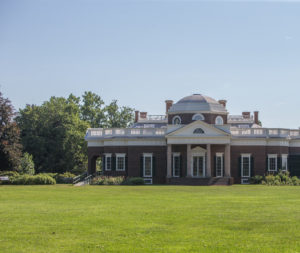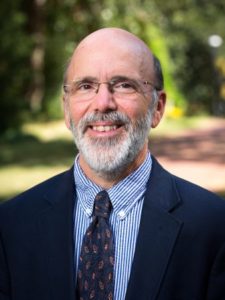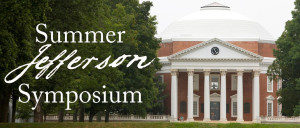Thomas Jefferson’s Last Legacies
Written by John Ragosta, Faculty Leader, Summer Jefferson Symposium; Fellow, Virginia Foundation for the Humanities
We remember Thomas Jefferson primarily for his great accomplishments as a statesman, philosopher, and political leader, including the Declaration of Independence, his presidency, and his leadership of a political movement. But Jefferson lived until he was 83 years old, the last eighteen years after retiring from the presidency and national political life, and these were productive years for the sage of Monticello. Returning to his beloved Charlottesville after decades in public service, Jefferson did not simply recline and sip fine wine (although he did a fair share of that as well). Instead, he set out to create two communities, communities which were very important to his perception of his own life and family and that of the republic. I am referring, of course, to the communities at Monticello and at the University of Virginia.

It is no surprise that Jefferson, the Enlightenment polymath, felt deeply about education. But his focus on education was far more than merely personal interest or academic curiosity. Jefferson saw an educated populace as central to the success of the new republic. In the case of religious freedom, he attacked the “kings, nobles, and priests” who had historically sought to impose a “tyranny over the mind of man.” Once religious freedom was established as a bedrock for a free thinking people, Jefferson viewed education as critical for citizens to function effectively in the new republic. It was essential that people understood their government and legal system, studied history, oversaw the actions of political leaders, actively engaged their fellow citizens in an ongoing discussion concerning the republic and its success, and participated in the polity. Without effective and broad-based education, the system simply would not work.
As the sage explained in the preamble to his proposed education law:
Experience hath shewn, that even under the best forms, those entrusted with power have, in time, and by slow operations, perverted it into tyranny; and it is believed that the most effectual means of preventing this would be, to illuminate, as far as practicable, the minds of the people at large…
For the system to operate “most effectual[ly],” the best and the brightest, not simply the wealthiest or most “well-borne,” had to be educated to take their place as citizens in the republic. To promote “publick happiness,” Jefferson lectured:
Those persons, whom nature hath endowed with genius and virtue, should be rendered by liberal education worthy to receive, and able to guard the sacred deposit of the rights and liberties of their fellow citizens, and that they should be called to that charge without regard to wealth, birth or other accidental condition or circumstance…
That is why, when Jefferson crafted a new proposed legal code for Virginia during the Revolution in an effort to make our laws consistent with our new republican form, a free and broad-based education was central to the plan, one promising a basic education to all (free) children, male and female, and providing for a free education through the university level for some of the most capable (male) students. Unfortunately, Jefferson’s education law was not adopted, but the idea that education stood at the center of the republic remained. While Jefferson was not successful in his efforts to enact publicly-funded primary and secondary education, he viewed with great pride, and great promise, the creation of UVA.

Yet, for the new university to fulfill its mission, it needed to be a community, a community in which all members, students and faculty, were engaged together in their pursuit of “truth wherever it may lead.” The design of the University, by creating pavilions in which faculty members would live and work and teach among their student colleagues, was not simply an architectural affectation, but a central part of the vision.
As the University begins the celebration of its bicentennial, it is this vision of an academic community (the “academical village”), central to the success not only of the students but of the new republic, which we plan to discuss next summer during the 2018 Summer Jefferson Symposium.
We will also revisit Monticello, an imagined community in Jefferson’s retirement which was not entirely dissimilar to the community Jefferson imagined on Grounds. Monticello was to be a refuge for Jefferson’s extended family (his community), and a place for his personal happiness. While at the center of that plantation was a large enslaved community, he recognized, out of necessity, that those enslaved people played an essential role in the family community he was creating (not to mention the family members he created among the enslaved community), and their role became part of his plan.
Our ideas about the 2018 Summer Jefferson Symposium are continuing to develop. I am sure that they will mature over the next few months. We are excited, though, particularly during the University’s bicentennial, for the opportunity to come together with scholars and participants to consider the two communities on which Jefferson lavished so much attention in his long retirement.
Join us for the Symposium in Charlottesville, VA, June 21-24, 2018! For more information and to register for the Symposium, please visit the Lifetime Learning website.
- Testing, Diagnosing, and Treating Primary Aldosteronism: A Leading Cause of Hard-to-Treat Hypertension
- Life at the Top: Climate Change in Utqiaġvik, Alaska
- The Only Thing We Have to Fear is Fear Itself
- UVA Club of Tidewater: Hoos at Harbor Park
- UVA Club of Washington, DC: Diplomacy & Dialogue with Ambassador Mull
- UVA Club of the Roanoke Valley: Admitted Student Celebration

